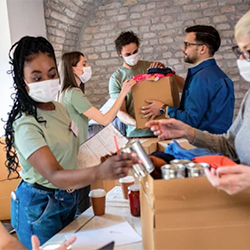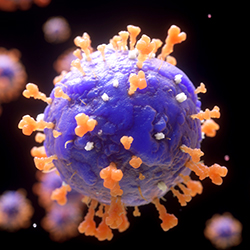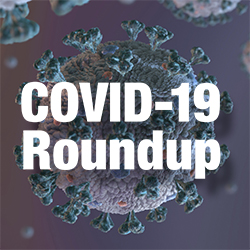By Marie Rosenthal, MS
The CDC lifted mask mandates for some communities, but not all. Masks should still be worn indoors in areas with high rates of COVID-19, according to Rochelle P. Walensky, MD, MPH, the director of the CDC, who spoke at a media briefing on Feb. 25.

However, communities that have low or medium levels of transmission can forgo the masks, even in classrooms.
“We're in a stronger place today as a nation, with more tools to protect ourselves and our communities from COVID-19—like vaccine boosters, broader access to testing, availability of high-quality masks, accessibility to new treatments and improved ventilation,” Dr. Walensky said.
“Over 200 million people have received a primary vaccine series, and nearly 100 million have been boosted, and millions more have had prior disease. With widespread population immunity, the overall risk of severe disease is now generally lower,” she noted.
In view of this progress, the CDC believed it was time to change the way it monitors the level of COVID-19 in the community. “We must focus our metrics beyond just cases in the community, and direct our efforts toward protecting people at high risk for severe illness and preventing COVID-19 from overwhelming our hospitals and our healthcare systems,” Dr. Walensky said.
This new surveillance framework will include data on hospitalizations and hospital capacity, not just cases and positive tests to determine whether the level of COVID-19 and severe disease are low, medium or high in a community, and that will give the CDC a better picture.
“The COVID-19 community level we are releasing today will inform CDC recommendations on prevention measures like masking, and CDC’s recommendations for layer prevention measures will depend on the COVID-19 level in the community,” she said. The goal is to keep hospitals and healthcare systems from becoming overwhelmed, she explained.
More than 70% of the U.S. population is in locations with low or medium COVID-19 activity, according to Greta Massetti, PhD, MPH, with the COVID-19 Response Incident Management Team. On Feb. 24, 23% of counties—or 29.5% of the population—were in areas with low rates of COVID-19, designated as green on the website; 39.6% of counties and 42.2% of the population were in areas with moderate rates of disease, designated as yellow on the website; and 37.3% of counties with 28.2% of the population (almost one-third) were in red zones having high rates of COVID-19.
“The updated metrics in this framework provide a current picture of COVID-19 disease in a community,” Dr. Massetti said. “They also include strong predictors of the potential for strain on the healthcare system.”
“A community’s COVID-19 level is determined by combining three pieces of information: new hospitalizations for COVID-19, current hospital beds occupied by COVID-19 patients or the hospital capacity; and new COVID-19 cases. These metrics will tell us if the level is low, medium or high,” Dr. Massetti said.
People can log on to theCDC website or call 1-800-CDC-INFO to find out the COVID-19 level in their communities.
Regardless of the level of infection, people should stay up-to-date with their vaccinations and should be tested if they have symptoms, she added.
“At the low level, there is limited impact on the healthcare system and low amounts of severe disease in the community,” Dr. Massetti said, so those people would not have to wear masks in public.
“At the medium level, more people are experiencing severe disease in the community, and they’re starting to see more impact on the healthcare system. At this level, the CDC recommends that people who are high risk, such as someone who is immunocompromised, should talk to their healthcare provider about taking additional precautions and may choose to wear a mask,” Dr. Massetti explained.
“As communities enter into the high level, there is a high amount of people experiencing severe disease and high potential for healthcare system strain. At the high level, the CDC recommends that everyone wears a mask indoors in public, including in schools,” she said.
Some people, such as immunocompromised individuals, those with underlying conditions that put them at risk, or those who live with people who are at risk “might choose to take extra precautions regardless of what level their community is in,” Dr. Walensky said. Anyone who feels safer wearing a mask should continue to wear one.
Gerald E. Harmon, MD, the president of the American Medical Association, reiterated the need for vaccination, but said he will continue wearing his mask.
“But even as some jurisdictions lift masking requirements, we must grapple with the fact that millions of people in the U.S. are immunocompromised, more susceptible to severe COVID outcomes, or still too young to be eligible for the vaccine,” he pointed out.
“In light of those facts, I personally will continue to wear a mask in most indoor public settings, and I urge all Americans to consider doing the same, especially in places like pharmacies, grocery stores, on public transportation—locations all of us, regardless of vaccination status or risk factors, must visit regularly.
“Although masks may no longer be required indoors in many parts of the U.S., we know that wearing a well-fitted mask is an effective way to protect ourselves and our communities, including the most vulnerable, from COVID-19—particularly in indoor settings when physical distancing is not possible.
“Wearing a mask, physical distancing and staying home if you’re sick are small but important protective measures that can help us all stay safe. While the omicron surge has declined, COVID-19 is not gone. We must remain adaptable and vigilant in confronting this unpredictable virus,” Dr. Harmon said.




